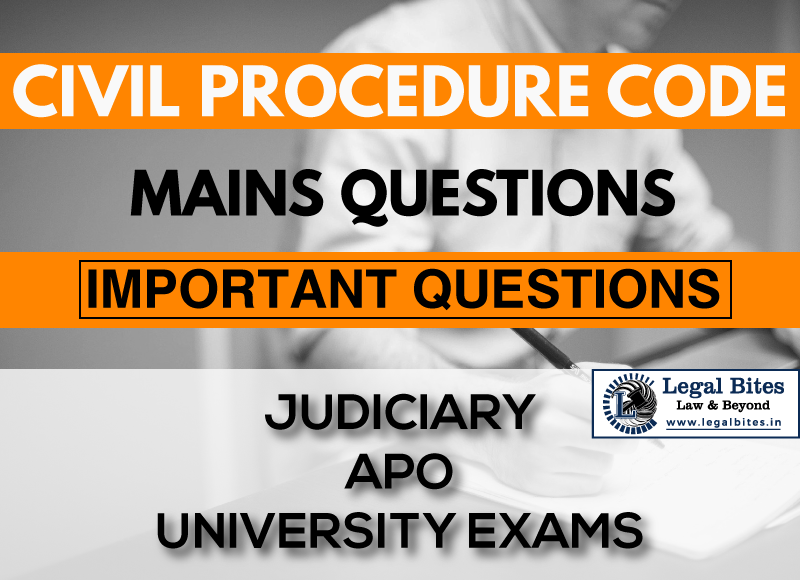Concepts of Admission and Affidavits under the Code of Civil Procedure, 1908
Admission under the Evidence Act, 1872 means, in simple terms, the acceptance of the statements or facts by the party who is referred to such fact. Under the Civil Procedure, examination-in-chief takes place through affidavits and all admissions are done through affidavits as well. Hence, this article shall assist in understanding the concepts of admission and affidavits under… Read More »
;
Admission under the Evidence Act, 1872 means, in simple terms, the acceptance of the statements or facts by the party who is referred to such fact. Under the Civil Procedure, examination-in-chief takes place through affidavits and all admissions are done through affidavits as well. Hence, this article shall assist in understanding the concepts of admission and affidavits under the Code of Civil Procedure, 1908. Introduction The civil procedure code in India envisages the concept of...
Admission under the Evidence Act, 1872 means, in simple terms, the acceptance of the statements or facts by the party who is referred to such fact. Under the Civil Procedure, examination-in-chief takes place through affidavits and all admissions are done through affidavits as well. Hence, this article shall assist in understanding the concepts of admission and affidavits under the Code of Civil Procedure, 1908.
Introduction
The civil procedure code in India envisages the concept of Admission. As the word itself suggests that it is an acknowledgment of something. In a court of law admission is done through three ways:
- Firstly, it is done through oral or documentary evidence available at the behest of the parties
- Secondly, it is done through the written submissions made by the parties. In simpler terms through the arguments made by the parties.
- Lastly, by agreement between the parties to recognize or accept particular evidence in whatsoever form.
I. How is an admission made?
As highlighted above admission is made either orally or through a document. Now, this admission is made under oath by a person who has knowledge of the facts and he then makes an admission through an affidavit. This affidavit need not be in usual circumstances proved if it is accompanied by annexures and relevant documents. However, Rule 1 specifies that the court may direct any of the party to prove the contents of the document if required.
Order XII and Order XIX go hand in hand and cannot be read in isolation. I shall be explaining admission and then how is an admission made by way of an affidavit.
Now the purpose of admission is to ensure that the court can move forward with the assumption that the ‘admission’ is truthful or reliable. However, the court may at its discretion under certain circumstances direct the party to prove the admission to ensure truthfulness.
The code of civil procedure envisages the concept of admission under Order XII of the enactment. Order XII further envisages certain rules made under laying down the procedure in further detail.
What is the procedure of admission by a party?
Rule 1 of Order XII states that if any party wants to admit a certain fact or evidence it can do so by sending a notice to the other party. This notice allows the other party to have more clarity about the admission made by the party. This notice requires the admitting party to specifically state the facts admitted, either in whole or in part.
On the other hand, if a plaint makes certain allegations and the written statement made as a reply to the plaint does not specifically deny the stated facts. It shall be deemed that the adverse party is making an admission of a certain fact according to Rule 2A of Order XII. Therefore, the written statement should have a reply to each and every paragraph of the plaint and when there is a failure to do so, it shall be deemed to be admitted by the adverse party.
This rule further comprises of a proviso which states that it is the discretion of the court to require any document so admitted to be proved otherwise than by such admission. When a party is sent a notice to admit certain facts but he fails to do so, it is the power of the court to pass an order directing him to pay costs.
Time limits prescribed under Rule 4 of Order XII.
Any of the two parties may give notice to the other party to admit a certain fact before Nine(9) days of the date of hearing fixed by the court. Now the receiving party shall if neglects this notice or refuses to reply to the same can be asked to pay costs for admission of the fact.
But it is to be noted, this time period can be extended by the court at its discretion. The court can allow the party to reject or withdraw such admission at any stage if it deems fit. Further, Rule 6 states that the court may pass judgment on the basis and consideration of these admissions made.
II. Affidavits
An affidavit is a sworn document by a person who has the knowledge of a fact to be true and it can be said that this person admits those facts to be true on Oath. The affidavit is signed by this person who is called the Deponent. Now it is important to note that since this document is on oath if the court finds out to be dishonest and untruthful the deponent can be held liable for the same. And a case of perjury i.e. lying to the court can be instituted before the court.
This affidavit is a certain type of guarantee that the facts and circumstances mentioned in the document are correct and to the best of his knowledge. Furthermore, this affidavit needs to be attested by the Notary (court-appointed officers) who ensures that the affidavit is signed by the deponent himself and is not forged in nature.
In civil cases, unlike criminal cases, the chief examination of a person is said to be taken on affidavit and the deponent can be cross-examined in the court with regards to the contents of the document presented as per Rule 2 under Order XIX.
Rule 3, further explains that an affidavit can only be made by a deponent based upon the facts which he himself has knowledge of, except Interlocutory applications in which statements he believes to be true are made.
But it also needs to be duly noted that Rule 5 furthers that court in its discretion redacts or reject any fact made on affidavit as a part of the chief examination. It may direct the party, to redact the examination in chief by way of affidavit if it feels that a certain portion is not relevant or are not evidence. And the court can furthermore also reject or return an affidavit if it is of the view that the contents are not admissible by the court.
Rule 6 states the guidelines which need to be followed while drafting of an affidavit. It is essential to ensure that the affidavit should contain relevant facts which are formatted in paragraphs and should be in the chronology of events as it has occurred. If the court at any time, observes that the contents of the affidavit are a mere copy or reproduction of the pleadings made by the party it can strike out portions or the whole affidavit as it deems fit.
Each paragraph of an affidavit should be distinct and separate from each other and deal with each subject matter at a time. if any paragraph requires an annexure or a document on which it is relying on it should be annexed to the affidavit and should refer to the specific page numbers as well as envisaged under rule 6(iv) of Order XIX.
Can an affidavit be treated as evidence?
The court can take the affidavit into evidence and if it qualifies according to the court and shall be treated as evidence under section 3 of the Indian Evidence Act. But there are precedents which specify what an affidavit should comprise of.
In the case of Padmabati Dasi v. Rasik Lal Dhar [(1910) ILR 37 Calcutta 259] the court observed that the affidavit should strictly comprise the rules laid down under Order XIX of CPC and should specifically provide that which portion of the affidavit the deponent had personal knowledge of and what is stated based upon deponents belief needs to be particularly highlighted. This will be useful for the court to decide what would be safe to rely upon as evidence.
Consequences of filing a False Affidavit
As it has been highlighted that the deponent shall perjure himself if he makes a false affidavit before the court. Moreover, there are several provisions of law which holds such persona liable and legal proceeding relying on the same can be instituted. It is a criminal offence under Section 191, 193, 195, 199 of Indian Penal Code, 1860 to make a false affidavit in one’s pleadings or filing false affidavit or false document in evidence before the court of law.
In addition to that since the deponent would have tried to mislead the court by giving such false evidences he can also be liable under the Contempt of Court Act.
Section 195 of CrPC specifically states that if any person intentionally fabricates or gives false evidence during any stage of a judicial proceeding shall be liable to be imprisoned and pay fine. And if a person intentionally gives fabricated or false evidence shall be liable to be imprisoned for a maximum period of 3 years.
References
- Dinshaw F. Mulla, The Key to Indian Practice: A Summary Of The Code Of Civil Procedure, 11th 2015.
- C. Sarkar, Sarkar Code of Civil Procedure, (2017).
- K. Takwani, Civil Procedure, 8th ed. 2018.



